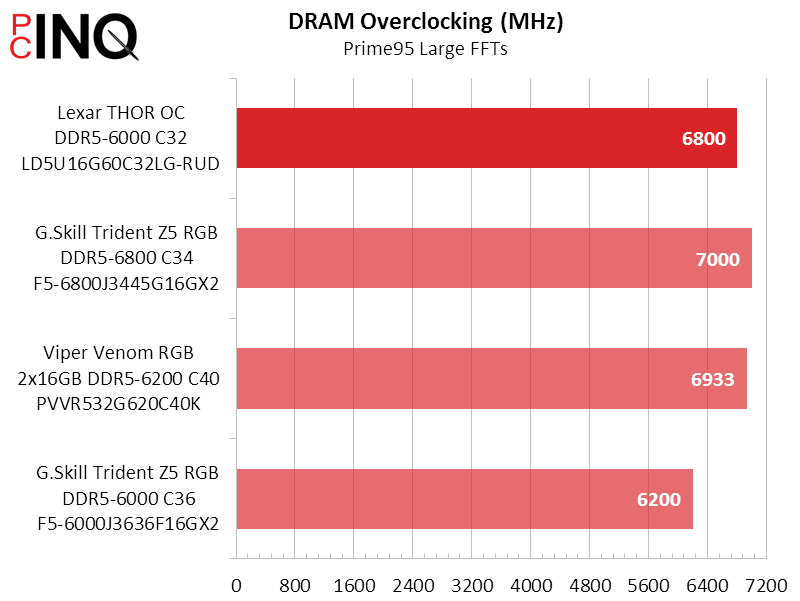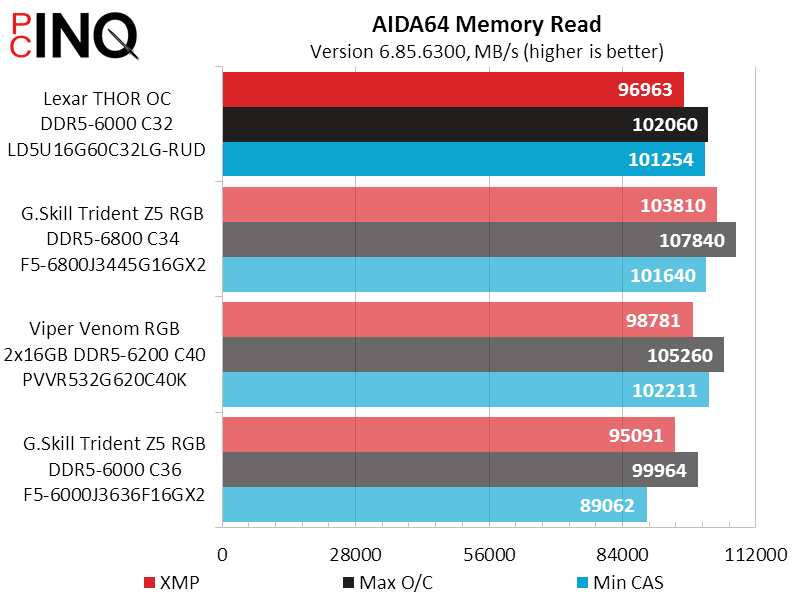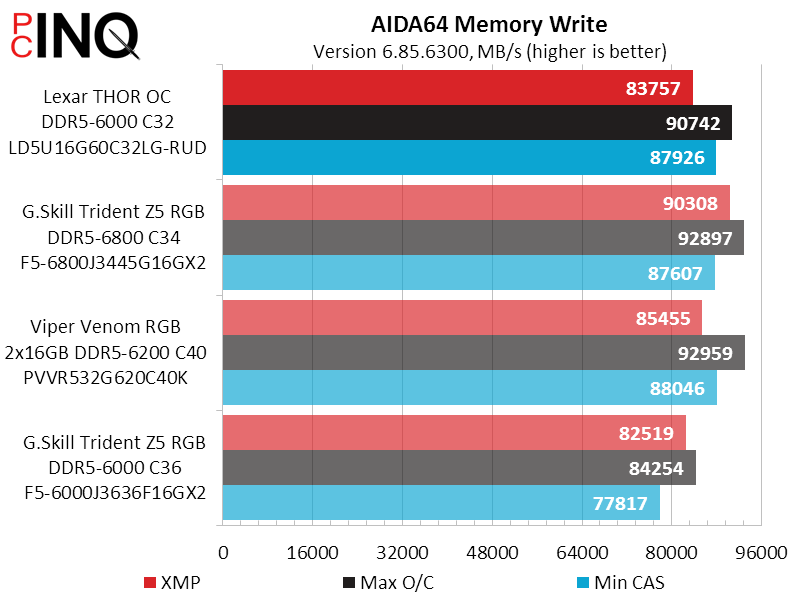Lexar Thor OC DDR5-6000 32GB Memory Review
It’s great that Lexar chose the “god of thunder” rather than of lightning for its latest high-speed DDR5 memory kits, as its Thor OC models have no lighting. The row of fake vents lining the top of each module does not conceal any RGB strip, but is instead what it appears to be. Fortunately, this part number LD5U16G60C32LG-RUD 2x16GB DDR5-6000 kit is priced accordingly.

| Lexar THOR OC model LD5U16G60C32LG-RUD | |
| Capacity | 32 GB (2x 16GB) |
| Data Rate | DDR5-6000 (EXPO, XMP) |
| Primary Timings | 32-38-38-96 (2T) |
| Voltage | 1.30 Volts |
| Height | 41mm |
| Warranty | Lifetime |
Inside the box was not so much as a manual, but just two modules in a clear plastic tray which we didn’t show because…it’s clear. Being that this low-cost kit contains the same Hynix ICs as our top sample, the first thing we cared about was seeing how well it could stand up to that costlier predecessor.

The basics are a bit less extreme than our previous DDR5-6800 kit, but they come at a less-extreme 1.300V which should be easier on things like our CPU’s memory controller and the interface between that and our CPU cores. Lexar even programs its DDR5-6000 overclock with both EXPO and XMP profiles, in hopes of reaching both Socket AM5 and LGA 1700 customers. Our Z690 motherboard supports both EXPO and XMP, and defaults to DDR5-4400 before one of those two profiles is activated in BIOS.

Lexar DRAM carries a lifetime limited warranty, though the DDR5 version of its Thor OC is so new that it has not yet been added to the firm’s detail list.
| Test Hardware | |
| CPU | Intel Core i9-13900K: 24C/32T, 3.0-5.8 GHz, 36 MB L3 Cache, LGA 1700 |
| CPU Cooler | Alphacool Core 1 Aurora, VPP655 with Eisbecher D5 150mm, NexXxoS UT60 X-Flow |
| Motherboard | ASRock Z690 Taichi LGA 1700, BIOS 13.05 |
| Graphics | Powercolor Red Devil Radeon 6750 XT: 2324-2623MHz GPU, 12GB GDDR6 |
| Power | be quiet! Dark Power Pro 10 850W: ATX12V v2.3, EPS12V, 80 PLUS Platinum |
| Hard Drive | Sabrent Rocket 4 Plus 2TB PCIe 4.0 M.2 SSD |
| Sound | Integrated HD Audio |
| Network | Integrated Wi-Fi |
| Graphics Driver | AMD Adrenalin Edition 2022.10.1 |
Overclocking & Latency Tuning
One of these kits is not like the others: G.Skill’s DDR5-6800 violates our 1.35V limit by requiring 1.40V to run its XMP…but the chips it uses were still picked well enough to run up to DDR5-7000 at our reduced 1.35V. Meanwhile, we increased the Lexar kit’s basic 1.30V XMP to 1.35V…and only got to DDR5-6800. The Lexar kit is also far cheaper and supports a far greater increase from its rated settings.

Even though it didn’t reach the same overclocking heights as its highest-priced rival, Thor OC still achieved the same super-tight timings. We probably don’t need to remind anyone that CAS 32 is pretty nice at DDR5-6400.
| Lowest Stable Timings | |||
| DDR5-6400 | DDR5-5600 | DDR5-4800 | |
| Lexar THOR OC DDR5-6000 C32 | 32-38-38-76 (2T) | 28-33-33-66 (2T) | 24-28-28-56 (2T) |
| G.Skill Trident Z5 RGB DDR5-6800 C34 | 32-38-38-76 (2T) | 28-33-33-66 (2T) | 24-28-28-56 (2T) |
| Viper Venom RGB 2x16GB DDR5-6200 C40 | 36-38-38-76 (2T) | 31-33-33-66 (2T) | 26-29-29-58 (2T) |
| G.Skill Trident Z5 RGB DDR5-6000 C36 | X | 31-31-31-62 (2T) | 28-28-28-56 (2T) |
Benchmark Results
We’ve already established that the Thor OC can match its top rivals in latency tuning, but we still wanted to see how its base XMP compared to those from G.Skill and Patriot. Sandra Bandwidth shows the Thor OC with slightly more bandwidth than G.Skill’s DDR5-6000 and slightly less than Patriot Viper’s DDR5-6200, and the advantage over the G.Skill kit is likely due to the way its lower latency allows the next packet to transfer sooner. It beats both those rivals in Sandra Latency, and its latency minimized configuration even mashes that of G.Skill’s DDR5-6800 in this one metric.






G.Skill’s DDR5-6800 edges out Lexar’s DDR5-6000 with both set to XMP. Surprisingly, the Thor OC wins when both are set to DDR5-6400 C32.

More is better in 7-Zip Synthetic score, but less is better in real-world compression time. The Viper Venom 6200 edges it out in both tests, while the Trident Z5 6000 splits its wins and losses over the Thor OC.


Performance differences get further muddled in Handbrake and Corona Bench, but averaging Handbrake completion time with 7-Zip compression time at least gets us to a nicely defined time benchmark percentage, where the Z5 6800 is best at stock settings, the Viper Venom has the best performing overclock, and the Thor OC beat the Z5 6000.



The Thor OC DDR5-6000 performs well enough at XMP values to make it a contender. Lexar scores points for supporting the same tight timing configurations as we had previously reached on G.Skill’s DDR5-6800, but Thor falls slightly behind the similarly priced Viper Venom RGB. If nothing else, its support for both EXPO and XMP makes Thor OC easier to recommend to someone who doesn’t know which technology their platform supports.
| Lexar THOR OC model LD5U16G60C32LG-RUD | |
| Pros | Cons |
| High value pricing Extreme tuning capability Includes XMP and EXPO | Pricier than non-RGB version of compared kit |
| The Verdict | |
| The Thor OC DDR5-6000 kit matches the performance and tuning ability of its high-end rivals while also supporting both EXPO and XMP technologies to get users started. | |


